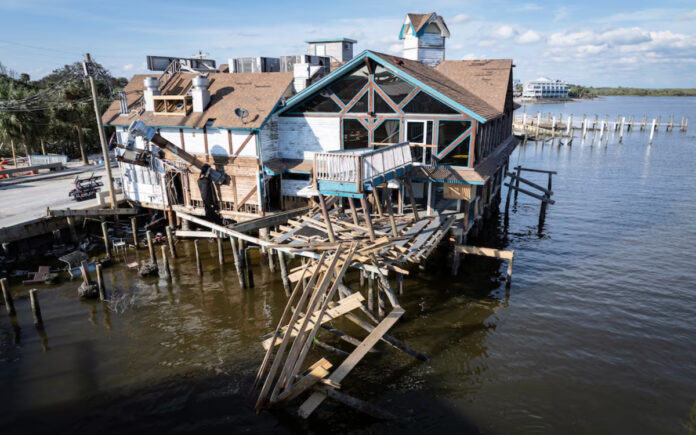Raleigh: States across the Southeastern U.S. launched an immense cleanup and recovery effort on Sunday after Hurricane Helene tore through the region, leaving millions without power, demolishing roads and bridges, and triggering widespread flooding from Florida to Virginia.
According to state and local officials, the storm has claimed at least 69 lives across South Carolina, Florida, Georgia, North Carolina, and Virginia. Authorities fear more bodies will be discovered as recovery efforts continue.
Preliminary damage estimates range between $15 billion and $100 billion, insurers and forecasters reported over the weekend. The full extent of property damage and economic disruption will become clearer as assessments progress.
In North Carolina, Governor Roy Cooper announced on Sunday that the death toll had risen to 11. “All roads in the western end of the state should be considered closed,” Cooper said, noting it could take months to repair the damage. Food and water are being airlifted to the most isolated areas.
“This is an unprecedented tragedy that requires an unprecedented response,” Cooper declared during a press conference.
In Flat Rock, North Carolina, widespread blackouts left residents queuing for hours at gas stations.
“Grocery stores are closed, cellphone service is out,” said Chip Frank, 62, as he waited in line for gas. “It all depends on these gas stations. You’re not going to be able to go nowhere, and it’s just a scary feeling.”
The Federal Emergency Management Agency (FEMA) reported that water systems, communications, and key transportation routes had been critically damaged across the affected region. The Army Corps of Engineers is set to begin assessing water system damage to expedite recovery efforts.
On Sunday, roughly 2.7 million customers were still without power, though that figure was down 40% from Friday’s peak, according to the U.S. Energy Department. The storm’s unprecedented surge, winds, and inland flooding continued to wreak havoc.
Florida’s Gulf Coast Hardest Hit
Helene struck Florida’s Gulf Coast on Thursday night, leaving a path of destruction in its wake. Homes that had stood for decades were flattened as relentless rain battered the region.
Florida Governor Ron DeSantis confirmed on Saturday that 11 people had died in the state. The Gulf Coast city of Perry saw storm surges reaching 15 feet, surpassing recent hurricanes.
In Horseshoe Beach, Charlene Huggins surveyed the wreckage of her family home, pulling a jacket from the rubble.
“Five generations lived in this house, from my grandmother, my father, myself, my daughter, son, and my granddaughter,” Huggins said, holding a chipped glass cake stand. “So there’s a lot of memories here. It just breaks your heart.”
Not far from Huggins, James Ellenburg stood on his family’s land, where four generations had lived. “I took my first step right here in this yard,” Ellenburg shared, standing amidst the destruction.
Steinhatchee, a nearby coastal town, experienced a storm surge of 8-10 feet, according to the weather service, with mobile homes among the worst hit.
David Hall, who owns a hotel in the Spring Warrior Fish Camp community, described the slow pace of aid. “No one thinks of us back here,” Hall said, as he and his wife sifted through debris in their office.
Also Read | Russian Hackers Leak Sensitive Data of Ukrainian Security Agent
North Carolina Suffers Catastrophic Flooding
Some of the heaviest rains hit western North Carolina, where Mount Mitchell in Yancey County recorded almost 30 inches of rainfall, according to the National Weather Service’s Weather Prediction Center. In Rutherford County, water poured over the Lake Lure Dam, while Chimney Rock’s downtown was described as completely washed out, with mud, uprooted trees, and snapped telephone poles littering the streets.
In nearby eastern Tennessee, officials feared that the Nolichucky Dam was nearing collapse. However, the Tennessee Valley Authority confirmed late Saturday that the dam remained stable.
“As we continue to support response and recovery efforts, we will make sure that no resource is spared to ensure communities can quickly begin their road to rebuilding,” U.S. President Joe Biden said in a statement on Sunday.
South Carolina recorded the highest death toll, with 24 fatalities, many caused by falling trees, local authorities said.
In Georgia, Governor Brian Kemp confirmed the deaths of 17 people, including children, following his tour of the storm’s damage in Valdosta.



